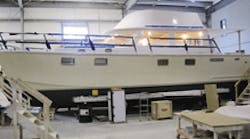Authored by: Edited by Jessica Shapiro Key points: Resources: “Basics of Design Engineering: Noise-control materials,” “Shaking Up Vibration Models,” Machine Design, Nov. 7, 2008, tinyurl.com/MDVibration |
Imagine riding in a boat speeding over the waves. But if instead of the rushing wind and surf, all you hear is the roar of the engine and all you feel is its vibration through the soles of your feet, your boat needs better damping.
Boat builders and manufacturers in virtually every industry use damping materials to reduce vibration and noise. These materials use one of two mechanisms to damp vibrations: extension and shear. Extension, the most common way to damp structure-borne noise and vibration, uses materials with viscoelastic properties that strain axially in response to vibrations.
These materials often find their way into boat bulkheads, decks, hulls, propeller planes, and the spaces between stringers where they dampen structure-borne vibrations that radiate away from the vibration source as noise.
Material options
Extension-damping materials include sheets or tiles as well as liquids that solidify in situ. Sheet damping materials may be asphalt-based or formed from plastisols (i.e., slurries of plastic particles, plasticizers, additives, and fillers that are cast into sheet forms).
Fillers in such plastisols are often as important as the base materials themselves. Inert fillers can improve flame retardation, low-density fillers can lighten the bulk material, and low-cost fillers cut material cost. Engineers must choose fillers, polymers, and plasticizers that are mutually compatible to permit high levels of loading.
The most common liquids are water-based slurries of vibration-damping latex particles with fillers like mica, graphite, calcium carbonate, or ceramic microspheres.
Two-part urethanes are an alternative to the water-based systems. Urethanes form exothermically at the point of application when an isocyanate and polyol (a polyester or polyether containing multiple hydroxyl groups) are mixed. The hydroxyl groups react with the isocyanate groups in the presence of a catalyst to form urethane linkages and create a cross-linked polymer.
The solid, viscoelastic urethanes bond well to the steel, aluminum, and fiberglass-reinforced polymers (FRP) used in boat building.
Ramped up damping
A material’s vibration-damping performance is often quoted in terms of loss factor, η. It’s a measure of the frequencies over which a damping material is effective at a given temperature.
One way to measure loss factor is by using the half-power-bandwidth technique. The method looks at vibration power at the resonant frequency and then determines frequencies corresponding to a response of half that power. The ratio of the difference between the two half-power frequencies and the resonant frequency is the loss factor. That is:
η = (ω2 – ω1) ÷ ωr
where ω2 is the higher of the two frequencies at half the power of the resonant peak, ω1 is the lower of the two frequencies, and ωr is the resonant frequency.
The technique is also called the 3-dB method because half power is 3 dB below the resonant peak.
ASTM E756-98 provides a way to test damping performance using a configuration recommended by SAE J1637. The setup attaches damping material to a 0.8 × 12.7 × 255-mm steel bar. The bar, also known as an Oberst bar, is clamped at one end and free at the other.
A magnetic transducer on the free end is the excitation driver, and a similar transducer on the clamped end measures damping response. A sound analyzer divides the response signal by the excitation signal to yield a transfer function that is ultimately used to calculate η. Engineers use the half-power-bandwidth technique to compute η over a temperature range of interest.
Materials with η greater than 0.1 are considered good performers. Plastisol tiles provide damping performance around η = 0.35 while urethanes and latex peak at η = 0.4 to 0.5. Both types of materials do their best damping at room temperature and still exhibit good damping between –18 and 54°C. In comparison, η for FRP is on the order of 0.01 and steel’s and aluminum’s are on the order of 0.001.
Saving time, losing weight
Finding damping materials for relatively thick parts — at least 3-mm-thick metal or 5-mm-thick fiberglass — has challenged marine engineers. The rule of thumb is that damping layers should be as thick as the structure.
One disadvantage of latex-based damping materials is the time-consuming application required for thick structures. Water-based latexes must be applied in layers no more than 1-mm thick so the water can evaporate. Each layer may take several hours to solidify, so building up a damping layer on a 6-mm-thick structural substrate could take a week.
Shorter installation times are one reason designers turn to exothermic-curing materials like urethanes. The urethane-forming isocyanate-polyol reaction is independent of material thickness. Urethanes are solid in 8 hr and fully cured in 24. And the exothermic nature of the reaction means installers can speed curing by raising the temperature.
Installation time is not an issue for sheet or tile materials, and many suppliers offer the option of pressure-sensitive adhesive (PSA) for peel-and-stick application. For sheets up to 0.25-in. thick and clean, smooth surfaces, PSAs simplify installation. For thicker sheets and rough surfaces, use a damping tile adhesive to improve the bond and fill in surface gaps.
Sheet materials compete on weight, not installation time. Average sheet materials have specific gravities in the 1.6-gm/cc range, but some fall as low as 1.05 gm/cc for weight-constrained applications.
Flammability
For many designers, a damping material’s ability to resist flame is just as important as installation time. Boat builders recognize International Marine Organization (IMO) test standard A.653(16) for measuring flame resistance as a function of a material’s critical flux (i.e., the heat needed to ignite a flame on the material). Materials with higher critical fluxes are more flame resistant.
The A.653(16) standard requires an entire damping system — substrate, adhesive, and damping material — to be tested together. Another common flammability test for plastics is Motor Vehicle Safety Standard 302 (MVSS 302), which evaluates plastic components individually.
